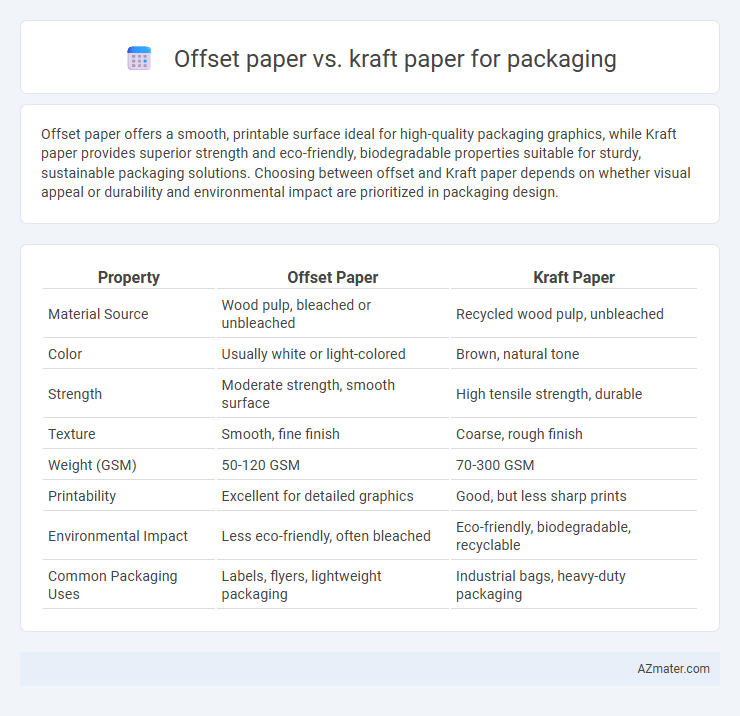Offset paper offers a smooth, printable surface ideal for high-quality packaging graphics, while Kraft paper provides superior strength and eco-friendly, biodegradable properties suitable for sturdy, sustainable packaging solutions. Choosing between offset and Kraft paper depends on whether visual appeal or durability and environmental impact are prioritized in packaging design.
Table of Comparison
| Property | Offset Paper | Kraft Paper |
|---|---|---|
| Material Source | Wood pulp, bleached or unbleached | Recycled wood pulp, unbleached |
| Color | Usually white or light-colored | Brown, natural tone |
| Strength | Moderate strength, smooth surface | High tensile strength, durable |
| Texture | Smooth, fine finish | Coarse, rough finish |
| Weight (GSM) | 50-120 GSM | 70-300 GSM |
| Printability | Excellent for detailed graphics | Good, but less sharp prints |
| Environmental Impact | Less eco-friendly, often bleached | Eco-friendly, biodegradable, recyclable |
| Common Packaging Uses | Labels, flyers, lightweight packaging | Industrial bags, heavy-duty packaging |
Introduction to Offset Paper and Kraft Paper
Offset paper, a smooth and high-quality material, is primarily used for printing detailed graphics and vibrant colors in packaging applications, ensuring crisp text and images. Kraft paper, known for its durability and natural brown appearance, offers excellent strength and eco-friendly properties, making it ideal for heavy-duty packaging and sustainable branding. Both materials serve distinct packaging needs, with offset paper excelling in visual appeal and kraft paper prioritizing robustness and environmental benefits.
Key Differences Between Offset Paper and Kraft Paper
Offset paper offers a smooth surface, ideal for high-quality printing and detailed graphics, making it popular for promotional packaging. Kraft paper is known for its durability and natural, coarse texture, providing excellent strength and environmental benefits in packaging applications. Key differences include print quality, texture, strength, and recyclability, with offset paper favoring aesthetics and kraft paper prioritizing toughness and eco-friendliness.
Material Composition and Manufacturing Process
Offset paper is primarily composed of high-quality wood pulp with minimal fillers and coatings, resulting in a smooth surface ideal for high-resolution printing, while Kraft paper is made from chemical pulp produced through the kraft process, giving it superior strength and durability. Offset paper manufacturing involves refining wood fibers and using calcium carbonate to enhance brightness and ink absorption, whereas Kraft paper undergoes a chemical pulping process that removes lignin, producing a coarse texture and robust material suited for heavy-duty packaging. The distinct material compositions and manufacturing methods directly influence their performance, with offset paper favored for detailed graphic packaging and Kraft paper preferred for sturdy, eco-friendly shipping applications.
Strength and Durability Comparison
Offset paper offers a smooth surface and moderate strength ideal for lightweight packaging, but it lacks the durability required for heavy-duty uses. Kraft paper, known for its high tensile strength and tear resistance, provides superior durability, making it suitable for robust packaging and protection during shipping. The superior fiber composition of kraft paper ensures enhanced impact resistance and longevity compared to offset paper.
Print Quality and Surface Finish
Offset paper offers exceptional print quality with sharp image reproduction and vibrant colors, making it ideal for detailed graphic packaging. Kraft paper features a rougher, textured surface that limits print sharpness but provides a natural, rustic aesthetic favored for eco-friendly branding. The smooth finish of offset paper enhances ink absorption and clarity, whereas kraft paper's coarse surface results in a more muted, organic print appearance.
Environmental Impact and Sustainability
Offset paper, made primarily from virgin wood pulp, is less sustainable due to its higher energy consumption and chemical usage in production compared to kraft paper. Kraft paper, produced through the kraft process using wood chips and fewer chemicals, offers superior biodegradability and recyclability, making it a more eco-friendly option for packaging. As a result, kraft paper is favored in sustainable packaging solutions for its lower environmental impact and better alignment with circular economy principles.
Cost Analysis for Packaging Applications
Offset paper generally offers a smoother surface and better print quality, but its higher production costs result in a more expensive option for packaging compared to Kraft paper. Kraft paper, made from unbleached wood pulp, is more cost-effective due to its lower material and manufacturing expenses, making it ideal for bulk packaging needs. Choosing Kraft paper can significantly reduce overall packaging costs, especially for heavy-duty or eco-friendly applications where price sensitivity is crucial.
Common Uses in Packaging Industries
Offset paper is widely used in packaging industries for high-quality printing applications such as product labels, promotional materials, and customized boxes due to its smooth surface and excellent ink absorption. Kraft paper is commonly preferred for shipping bags, wraps, and eco-friendly packaging because of its natural strength, durability, and recycled content. Both materials serve distinct purposes: offset paper enhances visual appeal, while kraft paper offers robust protection and sustainability.
Pros and Cons of Offset Paper for Packaging
Offset paper offers high print quality with sharp, vibrant images, making it ideal for packaging that demands detailed graphics and branding. However, it is less durable and less resistant to moisture compared to Kraft paper, which limits its suitability for heavy-duty or outdoor packaging. Its smooth surface enhances ink absorption and vibrant color reproduction, but it typically costs more and is less environmentally friendly than Kraft paper.
Pros and Cons of Kraft Paper for Packaging
Kraft paper offers exceptional durability and tear resistance, making it ideal for heavy-duty packaging and protecting products during shipping. Its eco-friendly, biodegradable nature appeals to sustainable packaging solutions, yet it tends to be rougher and less smooth compared to offset paper, which can limit its suitability for high-quality printing. Although kraft paper excels in strength, it may require additional treatments for moisture resistance, impacting cost-effectiveness in some packaging applications.

Infographic: Offset paper vs Kraft paper for Packaging
 azmater.com
azmater.com